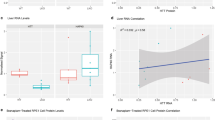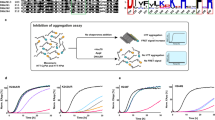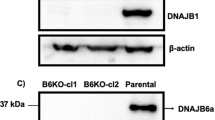Abstract
In Huntington disease, polyglutamine expansion of the protein huntingtin (Htt) leads to selective neurodegenerative loss of medium spiny neurons throughout the striatum by an unknown apoptotic mechanism. Binding of Hip-1, a protein normally associated with Htt, is reduced by polyglutamine expansion. Free Hip-1 binds to a hitherto unknown polypeptide, Hippi (Hip-1 protein interactor), which has partial sequence homology to Hip-1 and similar tissue and subcellular distribution. The availability of free Hip-1 is modulated by polyglutamine length within Htt, with disease-associated polyglutamine expansion favouring the formation of pro-apoptotic Hippi–Hip-1 heterodimers. This heterodimer can recruit procaspase-8 into a complex of Hippi, Hip-1 and procaspase-8, and launch apoptosis through components of the 'extrinsic' cell-death pathway. We propose that Htt polyglutamine expansion liberates Hip-1 so that it can form a caspase-8 recruitment complex with Hippi. This novel non-receptor-mediated pathway for activating caspase-8 might contribute to neuronal death in Huntington disease.
This is a preview of subscription content, access via your institution
Access options
Subscribe to this journal
Receive 12 print issues and online access
$209.00 per year
only $17.42 per issue
Buy this article
- Purchase on Springer Link
- Instant access to full article PDF
Prices may be subject to local taxes which are calculated during checkout










Similar content being viewed by others
References
The Huntington's Disease Collaborative Research Group. A novel gene containing a trinucleotide repeat that is expanded and unstable on Huntington's disease chromosomes. Cell 72, 971–983 (1993).
Kremer, B. et al. A worldwide study of the Huntington's disease mutation. The sensitivity and specificity of measuring CAG repeats. N. Engl. J. Med. 330, 1401–1406 (1994).
Dragunow, M. et al. In situ evidence for DNA fragmentation in Huntington's disease striatum and Alzheimer's disease temporal lobes. Neuroreport 6, 1053–1057 (1995).
Thomas, L. B. et al. DNA end labeling (TUNEL) in Huntington's disease and other neuropathological conditions. Exp. Neurol. 133, 265–272 (1995).
Portera-Cailliau, C., Hedreen, J. C., Price, D. L. & Koliatsos, V. E. Evidence for apoptotic cell death in Huntington disease and excitotoxic animal models. J. Neurosci. 15, 3775–3787 (1995).
Nihei, K. & Kowall, N. W. Neurofilament and neural cell adhesion molecule immunocytochemistry of Huntington's disease striatum. Ann. Neurol. 31, 59–63 (1992).
DiFiglia, M. et al. Aggregation of huntingtin in neuronal intranuclear inclusions and dystrophic neurites in brain. Science 277, 1990–1993 (1997).
Wellington, C. L. et al. Caspase cleavage of gene products associated with triplet expansion disorders generates truncated fragments containing the polyglutamine tract. J. Biol. Chem. 273, 9158–9167 (1998).
Sanchez, I. et al. Caspase-8 is required for cell death induced by expanded polyglutamine repeats. Neuron 22, 623–633 (1999).
Nicholson, D. W. & Thornberry, N. A. Caspases: killer proteases. Trends Biochem. Sci. 22, 299–306 (1997).
Muzio, M. et al. FLICE, a novel FADD-homologous ICE/CED-3-like protease, is recruited to the CD95 (Fas/APO-1) death-inducing signaling complex. Cell 85, 817–827 (1996).
Aravind, L., Dixit, V. M. & Koonin, E. V. The domains of death: evolution of the apoptosis machinery. Trends Biochem. Sci. 24, 47–53 (1999).
Hofmann, K., Bucher, P. & Tschopp, J. The CARD domain: a new apoptotic signalling motif. Trends Biochem. Sci. 22, 155–156 (1997).
Hackam, A. S. et al. Huntingtin interacting protein 1 induces apoptosis via a novel caspase-dependent death effector domain. J. Biol. Chem. 275, 41299–41308 (2000).
Holtzman, D. A., Yang, S. & Drubin, D. G. Synthetic-lethal interactions identify two novel genes, SLA1 and SLA2, that control membrane cytoskeleton assembly in Saccharomyces cerevisiae. J. Cell Biol. 122, 635–644 (1993).
Mulholland, J., Wesp, A., Riezman, H. & Botstein, D. Yeast actin cytoskeleton mutants accumulate a new class of Golgi-derived secretary vesicle. Mol. Biol. Cell 8, 1481–1499 (1997).
Wesp, A. et al. End4p/Sla2p interacts with actin-associated proteins for endocytosis in Saccharomyces cerevisiae. Mol. Biol. Cell 8, 2291–2306 (1997).
Raths, S., Rohrer, J., Crausaz, F. & Riezman, H. end3 and end4: two mutants defective in receptor-mediated and fluid-phase endocytosis in Saccharomyces cerevisiae. J. Cell Biol. 120, 55–65 (1993).
Metzler, M. et al. HIP1 functions in clathrin-mediated endocytosis through binding to clathrin and adaptor protein 2. J. Biol. Chem. 276, 39271–39276 (2001).
Kalchman, M. A. et al. HIP1, a human homologue of S. cerevisiae Sla2p, interacts with membrane-associated huntingtin in the brain. Nature Genet. 16, 44–53 (1997).
Sapp, E. et al. Axonal transport of N-terminal huntingtin suggests early pathology of corticostriatal projections in Huntington disease. J. Neuropathol. Exp. Neurol. 58, 165–173 (1999).
DiFiglia, M. Excitotoxic injury of the neostriatum: a model for Huntington's disease. Trends Neurosci. 13, 286–289 (1990).
Seki, N. et al. Cloning, expression analysis, and chromosomal localization of HIP1R, an isolog of huntingtin interacting protein (HIP1). J. Hum. Genet. 43, 268–271 (1998).
Chopra, V. S. et al. HIP12 is a non-proapoptotic member of a gene family including HIP1, an interacting protein with huntingtin. Mamm. Genome 11, 1006–1015 (2000).
Eberstadt, M. et al. NMR structure and mutagenesis of the FADD (Mort1) death-effector domain. Nature 392, 941–945 (1998).
Itoh, N. & Nagata, S. A novel protein domain required for apoptosis. Mutational analysis of human Fas antigen. J. Biol. Chem. 268, 10932–10937 (1993).
Rees, D. J., Ades, S. E., Singer, S. J. & Hynes, R. O. Sequence and domain structure of talin. Nature 347, 685–689 (1990).
Sato, N., Funayama, N., Nagafuchi, A., Yonemura, S. & Tsukita, S. A gene family consisting of ezrin, radixin and moesin. Its specific localization at actin filament/plasma membrane association sites. J. Cell Sci. 103, 131–143 (1992).
Tsukita, S. & Yonemura, S. ERM proteins: head-to-tail regulation of actin-plasma membrane interaction. Trends Biochem. Sci. 22, 53–58 (1997).
Tsukita, S. & Yonemura, S. ERM (ezrin/radixin/moesin) family: from cytoskeleton to signal transduction. Curr. Opin. Cell Biol. 9, 70–75 (1997).
Muguruma, M., Nishimuta, S., Tomisaka, Y., Ito, T. & Matsumura, S. Organization of the functional domains in membrane cytoskeletal protein talin. J. Biochem. 117, 1036–1042 (1995).
Hemmings, L. et al. Talin contains three actin-binding sites each of which is adjacent to a vinculin-binding site. J. Cell Sci. 109, 2715–2726 (1996).
Roy, S. & Nicholson, D. W. Cross-talk in cell death signaling. J. Exp. Med. 192, F21–F25. (2000).
Dragatsis, I., Levine, M. S. & Zeitlin, S. Inactivation of Hdh in the brain and testis results in progressive neurodegeneration and sterility in mice. Nature Genet. 26, 300–306 (2000).
Leavitt, B. R. et al. Wild-type huntingtin reduces the cellular toxicity of mutant huntingtin in vivo. Am. J. Hum. Genet. 68, 313–324 (2001).
Goldberg, Y. P. et al. Cleavage of huntingtin by apopain, a proapoptotic cysteine protease, is modulated by the polyglutamine tract. Nature Genet. 13, 442–449 (1996).
Nucifora, F. C., Jr et al. Interference by huntingtin and atrophin-1 with cbp-mediated transcription leading to cellular toxicity. Science 291, 2423–2428 (2001).
Garcia-Calvo, M. et al. Purification and catalytic properties of human caspase family members. Cell Death Differ. 6, 362–369 (1999).
Olmsted, J. B. Affinity purification of antibodies from diazotized paper blots of heterogeneous protein samples. J. Biol. Chem. 256, 11955–11957 (1981).
Gutekunst, C. A. et al. The cellular and subcellular localization of huntingtin-associated protein 1 (HAP1): comparison with huntingtin in rat and human. J. Neurosci. 18, 7674–7686 (1998).
Pagano, R. E., Sepanski, M. A. & Martin, O. C. Molecular trapping of a fluorescent ceramide analogue at the Golgi apparatus of fixed cells: interaction with endogenous lipids provides a trans-Golgi marker for both light and electron microscopy. J. Cell Biol. 109, 2067–2079 (1989).
Pagano, R. E., Martin, O. C., Kang, H. C. & Haugland, R. P. A novel fluorescent ceramide analogue for studying membrane traffic in animal cells: accumulation at the Golgi apparatus results in altered spectral properties of the sphingolipid precursor. J. Cell Biol. 113, 1267–1279 (1991).
Acknowledgements
We thank G. Shore for the kind gift of the dominant-negative caspase-8 mutant as well as Y.-Z. Yang for help in the generation of the Hip-1 monoclonal antibody and H. Yi for help with electron microscopy. This work was supported by grants to M.R.H. from the Canadian Institutes of Health Research (CIHR), the Huntington Disease Society of America (HDSA) and the Hereditory Disease Foundation (HDF).
Correspondence and requests for materials should be addressed to D.W.N.
Author information
Authors and Affiliations
Corresponding author
Rights and permissions
About this article
Cite this article
Gervais, F., Singaraja, R., Xanthoudakis, S. et al. Recruitment and activation of caspase-8 by the Huntingtin-interacting protein Hip-1 and a novel partner Hippi. Nat Cell Biol 4, 95–105 (2002). https://doi.org/10.1038/ncb735
Received:
Revised:
Accepted:
Published:
Issue Date:
DOI: https://doi.org/10.1038/ncb735
This article is cited by
-
The role of Smo-Shh/Gli signaling activation in the prevention of neurological and ageing disorders
Biogerontology (2023)
-
Wild-type huntingtin regulates human macrophage function
Scientific Reports (2020)
-
Gene Expression Signature of BRAF Inhibitor Resistant Melanoma Spheroids
Pathology & Oncology Research (2020)
-
Protective Effects of Antioxidants in Huntington’s Disease: an Extensive Review
Neurotoxicity Research (2019)
-
Manifestation of Huntington’s disease pathology in human induced pluripotent stem cell-derived neurons
Molecular Neurodegeneration (2016)



